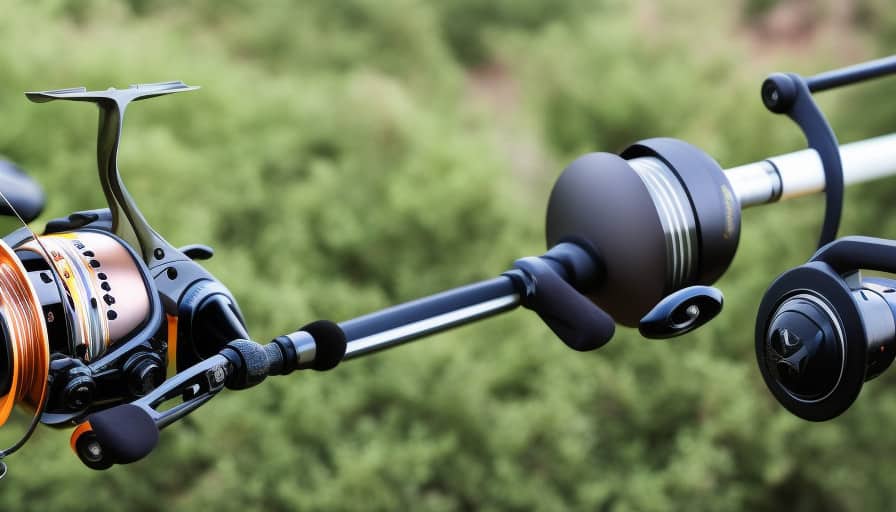Have you ever wondered how to effectively interpret the display on a fish finder screen?
This article aims to provide a comprehensive guide on understanding and interpreting the fish finder interface.
By analyzing sonar signals, fish arches, fish symbols, depth and bottom structure readings, as well as adjusting fish finder settings, readers will gain mastery over the reading and interpretation of fish finder screens.
This objective and detailed exploration of fish finder display interpretation is tailored to an audience seeking technical expertise in this domain.
Understanding the Fish Finder Interface
The understanding of the fish finder interface is essential for accurately interpreting the information displayed on the screen.
A fish finder is a tool used by anglers to locate and track fish underwater. The interface of a fish finder typically consists of a screen that displays various data and settings.
To identify fish species on the fish finder screen, anglers need to understand the different sonar signals and images produced by the device. Fish arches, for example, are commonly used to identify fish. These arches represent the movement of fish through the water column and can help anglers determine the size and location of the fish. Additionally, some fish finders offer advanced features such as fish ID icons, which can display specific fish species on the screen.
Another important aspect of the fish finder interface is the GPS and mapping features. These features allow anglers to mark and navigate to specific fishing spots, as well as create detailed maps of the underwater terrain. Utilizing these GPS and mapping features can greatly enhance the angler’s ability to locate and catch fish.
Overall, understanding the fish finder interface is crucial for effectively utilizing the device and maximizing its potential for successful fishing.
Interpreting Sonar Signals on the Display
Sonar signals on the display provide valuable information about the underwater environment. Interpreting these signals is crucial for understanding the fish finder display and making informed decisions while fishing. Two key aspects of interpreting sonar signals are target identification and water temperature readings.
The fish finder uses sonar technology to send out sound waves that bounce off objects in the water and return to the device. These sound waves are then translated into visual representations on the display. By analyzing these signals, anglers can identify potential fish targets and determine the water temperature, which can greatly impact fish behavior.
To interpret target identification, anglers should pay attention to the shape, size, and arches displayed on the fish finder. Fish targets typically appear as arches or elongated shapes, with larger fish producing larger arches. It is important to note that not all arches indicate fish; some may be caused by debris or vegetation.
Interpreting water temperature readings is also essential for successful fishing. Different fish species have specific temperature preferences, so understanding the water temperature can help anglers locate areas where fish are likely to be present. Warmer water temperatures may indicate shallower areas or areas with higher fish activity, while colder water temperatures may suggest deeper or less active fish.
In summary, interpreting sonar signals on the fish finder display involves analyzing target identification and water temperature readings. By mastering these skills, anglers can optimize their fishing strategies and increase their chances of a successful catch.
| Target Identification | Water Temperature Readings |
|---|---|
| Shape, size, arches | Fish behavior indicators |
| Elongated shapes | Temperature preferences |
| Larger arches | Shallow or deeper areas |
| Debris or vegetation | Fish activity levels |
| Optimal fishing locations |
Analyzing Fish Arches and Fish Symbols
Analyzing the shape and size of the arches and symbols on the fish finder display provides valuable information for identifying potential fish targets.
Fish arches are commonly observed on fish finder screens and indicate the presence of fish in the water column. These arches are formed due to the movement of fish in relation to the sonar beam emitted by the fish finder. The size of the arch can give insights into the size of the fish. Larger arches typically indicate larger fish, while smaller arches suggest smaller fish.
Additionally, the presence of fish symbols on the display can further aid in identifying fish targets. These symbols are often used to represent fish that are stationary or holding in a specific area. By analyzing the behavior of the fish symbols, such as their position and movement patterns, anglers can gain valuable information about the fish’s activity and location.
Moreover, analyzing baitfish patterns can provide additional clues about fish behavior. Baitfish often appear as dense schools or clusters on the fish finder display. Identifying these patterns can indicate the presence of predatory fish in the vicinity, as they are likely to be attracted to areas with abundant prey.
Overall, analyzing fish arches, symbols, and baitfish patterns on the fish finder display is crucial for identifying potential fish targets and understanding fish behavior.
Decoding Depth and Bottom Structure Readings
Decoding depth and bottom structure readings provides essential information about the underwater topography and composition. By analyzing these readings, anglers can gain insights into the presence of fish and identify potential fishing spots. One of the key challenges in interpreting fish finder displays is distinguishing between fish and underwater debris. Different fish species produce different sonar signals, and understanding these signals can help identify the species present. Similarly, differentiating between fish and underwater debris is crucial to avoid wasting time and effort on non-productive areas.
To assist in decoding fish finder readings, anglers can refer to the following table:
| Fish Species | Sonar Signal Characteristics |
|---|---|
| Bass | Arch-shaped signals |
| Trout | Small, scattered signals |
| Catfish | Large, elongated signals |
| Pike | Sharp, distinct signals |
Reading and Adjusting Fish Finder Settings
Adjusting the settings of a fish finder device allows users to optimize the display for better visibility and interpretation of underwater data. One important setting to consider is the sensitivity, which determines how the fish finder detects and displays signals. By adjusting the sensitivity settings, users can enhance the device’s ability to identify fish species and other underwater objects.
The sensitivity setting on a fish finder controls the device’s ability to detect and interpret signals. Increasing the sensitivity can make the fish finder more sensitive to weak signals, allowing it to detect smaller fish or objects. However, setting the sensitivity too high can result in excessive noise and clutter on the display. Conversely, decreasing the sensitivity can reduce noise and clutter, but may also cause the fish finder to miss weaker signals.
To identify fish species using a fish finder, users should adjust the sensitivity to a level where they can clearly distinguish fish arches on the display. Fish arches are characteristic patterns that represent fish passing through the sonar beam. By adjusting the sensitivity, users can ensure that the fish arches are well-defined and easily distinguishable from other signals, such as clutter or bottom structure.
Conclusion
In conclusion, understanding how to read a fish finder screen is crucial for successful fishing. By interpreting the sonar signals, analyzing fish arches and symbols, and decoding depth and bottom structure readings, anglers can gain valuable insights into the underwater world.
By reading and adjusting the fish finder settings, users can optimize their fishing experience. One interesting statistic to consider is that according to a study conducted by the American Sportfishing Association, recreational fishing contributes over $125 billion annually to the U.S. economy, highlighting the significance of effective fish finder usage in this popular hobby.



Leave a Reply